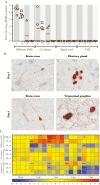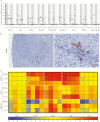1918 H1N1 Influenza Virus Replicates and Induces Proinflammatory Cytokine Responses in Extrarespiratory Tissues of Ferrets
- PMID: 29329410
- PMCID: PMC6018876
- DOI: 10.1093/infdis/jiy003
1918 H1N1 Influenza Virus Replicates and Induces Proinflammatory Cytokine Responses in Extrarespiratory Tissues of Ferrets
Abstract
Background: The 1918 Spanish H1N1 influenza pandemic was the most severe recorded influenza pandemic with an estimated 20-50 million deaths worldwide. Even though it is known that influenza viruses can cause extrarespiratory tract complications-which are often severe or even fatal-the potential contribution of extrarespiratory tissues to the pathogenesis of 1918 H1N1 virus infection has not been studied comprehensively.
Methods: Here, we performed a time-course study in ferrets inoculated intranasally with 1918 H1N1 influenza virus, with special emphasis on the involvement of extrarespiratory tissues. Respiratory and extrarespiratory tissues were collected after inoculation for virological, histological, and immunological analysis.
Results: Infectious virus was detected at high titers in respiratory tissues and, at lower titers in most extrarespiratory tissues. Evidence for active virus replication, as indicated by the detection of nucleoprotein by immunohistochemistry, was observed in the respiratory tract, peripheral and central nervous system, and liver. Proinflammatory cytokines were up-regulated in respiratory tissues, olfactory bulb, spinal cord, liver, heart, and pancreas.
Conclusions: 1918 H1N1 virus spread to and induced cytokine responses in tissues outside the respiratory tract, which likely contributed to the severity of infection. Moreover, our data support the suggested link between 1918 H1N1 infection and central nervous system disease.
Figures





References
-
- Chi Y, Zhu Y, Wen T et al. Cytokine and chemokine levels in patients infected with the novel avian influenza A (H7N9) virus in China. J Infect Dis 2013; 208:1962–7. - PubMed
Publication types
MeSH terms
Substances
LinkOut - more resources
Full Text Sources
Other Literature Sources

